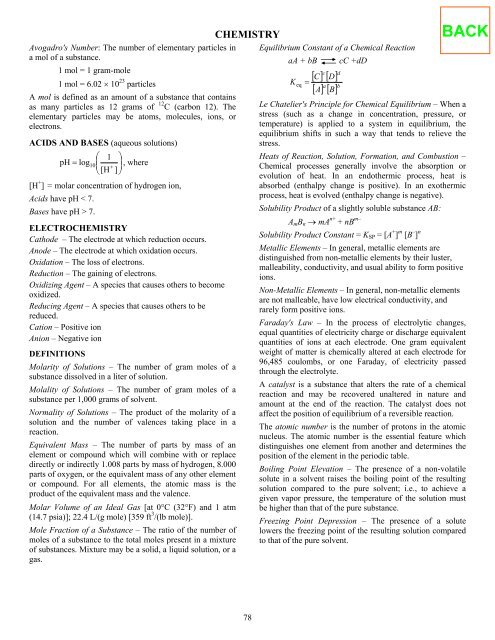fundamentals of engineering supplied-reference handbook - Ventech!
fundamentals of engineering supplied-reference handbook - Ventech!
fundamentals of engineering supplied-reference handbook - Ventech!
Create successful ePaper yourself
Turn your PDF publications into a flip-book with our unique Google optimized e-Paper software.
Avogadro's Number: The number <strong>of</strong> elementary particles in<br />
a mol <strong>of</strong> a substance.<br />
1 mol = 1 gram-mole<br />
1 mol = 6.02 × 10 23 particles<br />
A mol is defined as an amount <strong>of</strong> a substance that contains<br />
as many particles as 12 grams <strong>of</strong> 12 C (carbon 12). The<br />
elementary particles may be atoms, molecules, ions, or<br />
electrons.<br />
ACIDS AND BASES (aqueous solutions)<br />
⎛ 1 ⎞<br />
pH = log ⎜ ⎟<br />
10 ⎜ + ⎟<br />
, where<br />
⎝ [H ] ⎠<br />
[H + ] = molar concentration <strong>of</strong> hydrogen ion,<br />
Acids have pH < 7.<br />
Bases have pH > 7.<br />
ELECTROCHEMISTRY<br />
Cathode – The electrode at which reduction occurs.<br />
Anode – The electrode at which oxidation occurs.<br />
Oxidation – The loss <strong>of</strong> electrons.<br />
Reduction – The gaining <strong>of</strong> electrons.<br />
Oxidizing Agent – A species that causes others to become<br />
oxidized.<br />
Reducing Agent – A species that causes others to be<br />
reduced.<br />
Cation – Positive ion<br />
Anion – Negative ion<br />
DEFINITIONS<br />
Molarity <strong>of</strong> Solutions – The number <strong>of</strong> gram moles <strong>of</strong> a<br />
substance dissolved in a liter <strong>of</strong> solution.<br />
Molality <strong>of</strong> Solutions – The number <strong>of</strong> gram moles <strong>of</strong> a<br />
substance per 1,000 grams <strong>of</strong> solvent.<br />
Normality <strong>of</strong> Solutions – The product <strong>of</strong> the molarity <strong>of</strong> a<br />
solution and the number <strong>of</strong> valences taking place in a<br />
reaction.<br />
Equivalent Mass – The number <strong>of</strong> parts by mass <strong>of</strong> an<br />
element or compound which will combine with or replace<br />
directly or indirectly 1.008 parts by mass <strong>of</strong> hydrogen, 8.000<br />
parts <strong>of</strong> oxygen, or the equivalent mass <strong>of</strong> any other element<br />
or compound. For all elements, the atomic mass is the<br />
product <strong>of</strong> the equivalent mass and the valence.<br />
Molar Volume <strong>of</strong> an Ideal Gas [at 0°C (32°F) and 1 atm<br />
(14.7 psia)]; 22.4 L/(g mole) [359 ft 3 /(lb mole)].<br />
Mole Fraction <strong>of</strong> a Substance – The ratio <strong>of</strong> the number <strong>of</strong><br />
moles <strong>of</strong> a substance to the total moles present in a mixture<br />
<strong>of</strong> substances. Mixture may be a solid, a liquid solution, or a<br />
gas.<br />
CHEMISTRY<br />
78<br />
Equilibrium Constant <strong>of</strong> a Chemical Reaction<br />
aA + bB cC +dD<br />
K =<br />
eq<br />
[ ] [ ]<br />
[ ] [ ] b a<br />
c d<br />
C D<br />
A B<br />
Le Chatelier's Principle for Chemical Equilibrium – When a<br />
stress (such as a change in concentration, pressure, or<br />
temperature) is applied to a system in equilibrium, the<br />
equilibrium shifts in such a way that tends to relieve the<br />
stress.<br />
Heats <strong>of</strong> Reaction, Solution, Formation, and Combustion –<br />
Chemical processes generally involve the absorption or<br />
evolution <strong>of</strong> heat. In an endothermic process, heat is<br />
absorbed (enthalpy change is positive). In an exothermic<br />
process, heat is evolved (enthalpy change is negative).<br />
Solubility Product <strong>of</strong> a slightly soluble substance AB:<br />
AmBn → mA n+ + nB m–<br />
Solubility Product Constant = KSP = [A + ] m [B – ] n<br />
Metallic Elements – In general, metallic elements are<br />
distinguished from non-metallic elements by their luster,<br />
malleability, conductivity, and usual ability to form positive<br />
ions.<br />
Non-Metallic Elements – In general, non-metallic elements<br />
are not malleable, have low electrical conductivity, and<br />
rarely form positive ions.<br />
Faraday's Law – In the process <strong>of</strong> electrolytic changes,<br />
equal quantities <strong>of</strong> electricity charge or discharge equivalent<br />
quantities <strong>of</strong> ions at each electrode. One gram equivalent<br />
weight <strong>of</strong> matter is chemically altered at each electrode for<br />
96,485 coulombs, or one Faraday, <strong>of</strong> electricity passed<br />
through the electrolyte.<br />
A catalyst is a substance that alters the rate <strong>of</strong> a chemical<br />
reaction and may be recovered unaltered in nature and<br />
amount at the end <strong>of</strong> the reaction. The catalyst does not<br />
affect the position <strong>of</strong> equilibrium <strong>of</strong> a reversible reaction.<br />
The atomic number is the number <strong>of</strong> protons in the atomic<br />
nucleus. The atomic number is the essential feature which<br />
distinguishes one element from another and determines the<br />
position <strong>of</strong> the element in the periodic table.<br />
Boiling Point Elevation – The presence <strong>of</strong> a non-volatile<br />
solute in a solvent raises the boiling point <strong>of</strong> the resulting<br />
solution compared to the pure solvent; i.e., to achieve a<br />
given vapor pressure, the temperature <strong>of</strong> the solution must<br />
be higher than that <strong>of</strong> the pure substance.<br />
Freezing Point Depression – The presence <strong>of</strong> a solute<br />
lowers the freezing point <strong>of</strong> the resulting solution compared<br />
to that <strong>of</strong> the pure solvent.
















